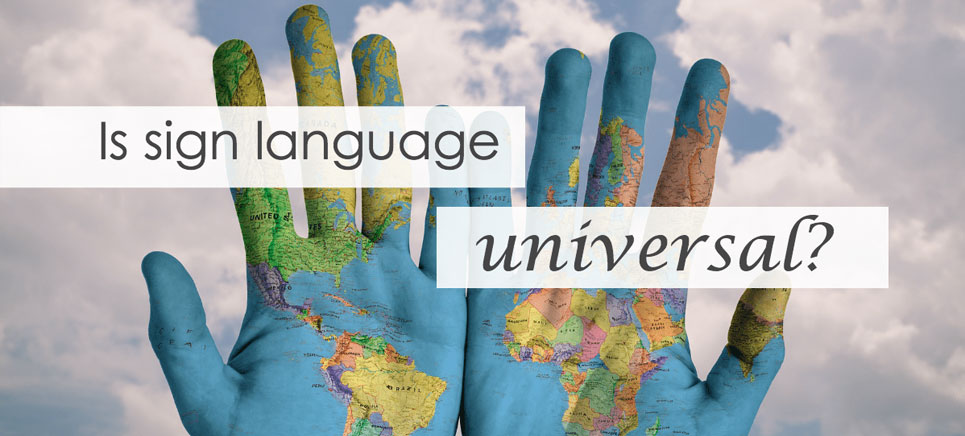Language, whether spoken or signed, is a tool of communication. But this tool of communication can sometimes create a communication gap when two people do not have a common language. This is the reason globalization came with a demand for a standardized language for international platforms. English, more or less, is functioning as that unifying standardized language in spoken or written form. But, is there any sign language that can be used as a common tool of communication for deaf people around the globe? Let’s find out!
Is there a Sign Language corresponding to English?
When we are using English as an international language on global platforms, it is natural to question whether there is any ‘English Sign Language’ that is used on global platforms for the deaf. It is important to understand that sign languages are independent of the spoken languages and have their separate origins. American Sign Language (ASL) and British Sign Language (BSL) for example are both used for expressing English letters and words but they are entirely different from each other. In a nutshell, there is no single sign language equivalent to the spoken English language.
Is there any need for a standardized international sign language?
The world is shrinking every day not only for the hearing population but for the deaf people too. There are international organizations like the World Federation of the Deaf (WFD). International events like World Hearing Day, Deaflympics and Miss & Mister Deaf World are being held. Deaf people from around the world are traveling and attending such international events. So, a standardized sign language is needed to let deaf people from around the world communicate with each other effectively.
It should be noted here that developing a standardized sign language does not mean homogenization of all the sign languages around the world. Just like the spoken languages, each sign language is special and carries the cultural aspect of the area where it developed.

History and Development of International Sign Language
The first evidential account of deaf people using an international mode of communication can be traced back to 1924 during the International Games for the Deaf (now known as Deaflympics).
During the 1970s, the British Deaf Association initiated an attempt to create standardized signs. A set of standardized signs to be used at WFD meetings and other international platforms, called Gestuno, was created. However, this set of signs was not accepted widely.
No sign language has yet been developed as a properly standardized global language. But, International Sign (IS), a pidgin sign language is mostly considered as the international language for the deaf. It is used formally during international events as well as informally by international deaf travelers.
International Sign (IS) is not considered a full language but a pidgin because the meaning of certain gestures and signs are to be negotiated between the signers. The signers use some highly iconic signs that can be understood by a large audience. Moreover, it is really tough to teach anybody International Sign (IS) if the person does not already know any national sign languages. Anyone interested in learning International Sign needs to have exposure to a number of sign languages and different signing styles. It is often noticed that the IS used by a signer is heavily influenced by her mother sign-language. A signer whose primary sign language is ASL translates something in ASL heavy International Sign while a European’s IS will be influenced more by her primary sign language.
Due to the above-mentioned limitations, many people demand ending the use of International Sign on international platforms. It is suggested that any actual sign language should be adopted as lingua-franca just like English is used among the hearing and speaking community.
Presently, there is no international sign language that can be used by deaf people around the world. International Sign (IS) is just a pidgin or an auxiliary language which is currently being used to fill the language divide between signers from different area and ethnicity.
Use the citation below to add this article to your bibliography
"International Sign Language: Is there One Sign Language for All?." Wecapable.com. Web. June 15, 2025. <https://wecapable.com/international-sign-language-universal-global/>
Wecapable.com, "International Sign Language: Is there One Sign Language for All?." Accessed June 15, 2025. https://wecapable.com/international-sign-language-universal-global/
"International Sign Language: Is there One Sign Language for All?." (n.d.). Wecapable.com. Retrieved June 15, 2025 from https://wecapable.com/international-sign-language-universal-global/

Imo resistance to the evolution of an international sign language reflects US and Brit imperialism
Hi Peggy – what I is ‘imo’? Resistance to evolution is very short-sighted isn’t it? There surely must be a way? What do you think?
Alison
‘imo’ means ‘in my opinion’.
There are words that can be commonly translated while some few should be left to the native countries since there are things that some countries have while other countries do not have.
I’ve lived (and plan to keep doing that) in different countries and continents, and I was always able to communicate with people knowing english, spanish and portuguese. However, I wish there was an international language for communication with deaf people, but for what it seems, there isn’t, so I wonder if I should learn ASL or other sign language and then IS, in order to be able to interact with any individual, regardless of their nationality.
Hello,
Do you have a source for learning International Sign? I’ve been scrolling google for quite a bit yet I haven’t found one.